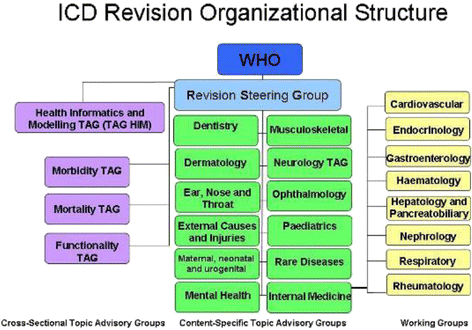Rare diseases in ICD11: making rare diseases visible in health information systems through appropriate coding
- PMID: 25887186
- PMCID: PMC4377208
- DOI: 10.1186/s13023-015-0251-8
Rare diseases in ICD11: making rare diseases visible in health information systems through appropriate coding
Abstract
Background: Because of their individual rarity, genetic diseases and other types of rare diseases are under-represented in healthcare coding systems; this contributes to a lack of ascertainment and recognition of their importance for healthcare planning and resource allocation, and prevents clinical research from being performed.
Methods: Orphanet was given the task to develop an inventory of rare diseases and a classification system which could serve as a template to update International terminologies. When the World Health Organization (WHO) launched the revision process of the International Classification of Diseases (ICD), a Topic Advisory Group for rare diseases was established, managed by Orphanet and funded by the European Commission.
Results: So far 5,400 rare diseases listed in the Orphanet database have an endorsed representation in the foundation layer of ICD-11, and are thus provided with a unique identifier in the Beta version of ICD-11, which is 10 times more than in ICD10. A rare disease linearization is also planned. The current beta version is open for public consultation and comments, and to be used for field testing. The adoption by the World Health Assembly is planned for 2017.
Conclusions: The overall revision process was carried out with very limited means considering its scope, ambition and strategic significance, and experienced significant hurdles and setbacks. The lack of funding impacted the level of professionalism that could be attained. The contrast between the initially declared goals and the currently foreseen final product is disappointing. In the context of uncertainty around the outcome of the field testing and the potential willingness of countries to adopt this new version, the European Commission Expert Group on Rare Diseases adopted in November 2014 a recommendation for health care coding systems to consider using ORPHA codes in addition to ICD10 codes for rare diseases having no specific ICD10 codes. The Orphanet terminology, classifications and mappings with other terminologies are freely available at www.orphadata.org.
Figures
References
-
- Rodwell C, Aymé S, eds. 2014 Report on the State of the Art of Rare Disease Activities in Europe, July 2014. [http://www.eucerd.eu/upload/file/Reports/2014ReportStateofArtRDActivitie...]. Accessed 19 January 2015.
-
- Regulation (EC) N°141/2000 of the European Parliament and of the Council of 16 December 1999 on orphan medicinal products, 16 December 1999. [http://lex.europa.eu/LexUriServ/LexUriServ.do?uri=OJ:L:2000:018:0001:000...] Accessed 19 January 2015.
-
- Orphanet: Orphanet 2013 Activity Report. [http://www.orpha.net/orphacom/cahiers/docs/GB/ActivityReport2013.pdf] Accessed 19 January 2015.
Publication types
MeSH terms
LinkOut - more resources
Full Text Sources
Other Literature Sources
Medical



